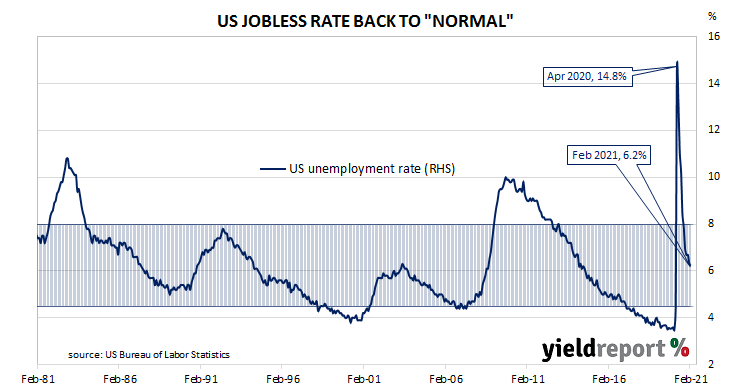Summary: February non-farm payrolls increase much more than expected; December, January figures revised up modestly; jobless rate declines, participation rate steady; “true” jobless rate 10%; end-of-year hiring lull “over”; jobs-to-population ratio up again; underemployment rate steady, Hourly pay growth unchanged.
The US economy ceased producing jobs in net terms as infection controls began to be implemented in March 2020. The unemployment rate had been around 3.5% but that changed as job losses began to surge through March and April of 2020. The May 2020 non-farm employment report represented a turning point and subsequent months provided substantial employment gains. Changes in recent months have been more modest but mostly positive.
According to the US Bureau of Labor Statistics, the US economy created an additional 379,000 jobs in the non-farm sector in February. The increase was well above the 100,000 which had been generally expected earlier in the week and more than double the 166,000 jobs which had been added in January after revisions. Employment figures for December and January were revised up by a total of 38,000.
The unemployment rate declined again, from January’s rate of 6.3% to 6.2%. The total number of unemployed decreased by 0.158 million to 9.972 million while the total number of people who are either employed or looking for work increased by 50,000 to 160.211 million. The small rise in the number of people in the labour force was not enough to change the participation rate from January’s rate of 61.4%.
NAB Head of FX Strategy within its FICC division said, “While the headline payroll number was taken at face value with markets initially responding accordingly, Treasury Secretary Janet Yellen was quick to remind us that taking into account that some 4 million people have dropped out of the labour force during the pandemic, the true unemployment rate is 10%.”

Short-term US Treasury yields declined a touch but long-term yields moved substantially higher on the day. By the close of business, the 2-year bond yield had slipped 1bp to 0.13% while the 10-year yield had gained 8bps to 1.56% and the 30-year yield finished 4bps higher at 2.32%.
ANZ Head of Australian Economics David Plank said, “Most of the job gains came in leisure and hospitality, particularly food services and drinking places, as the COVID infection rate receded. Employment in construction fell, but that was due to weather disruptions.” He said December’s fiscal stimulus had played a part “and that the lull in hiring over the turn of the year is over.”

